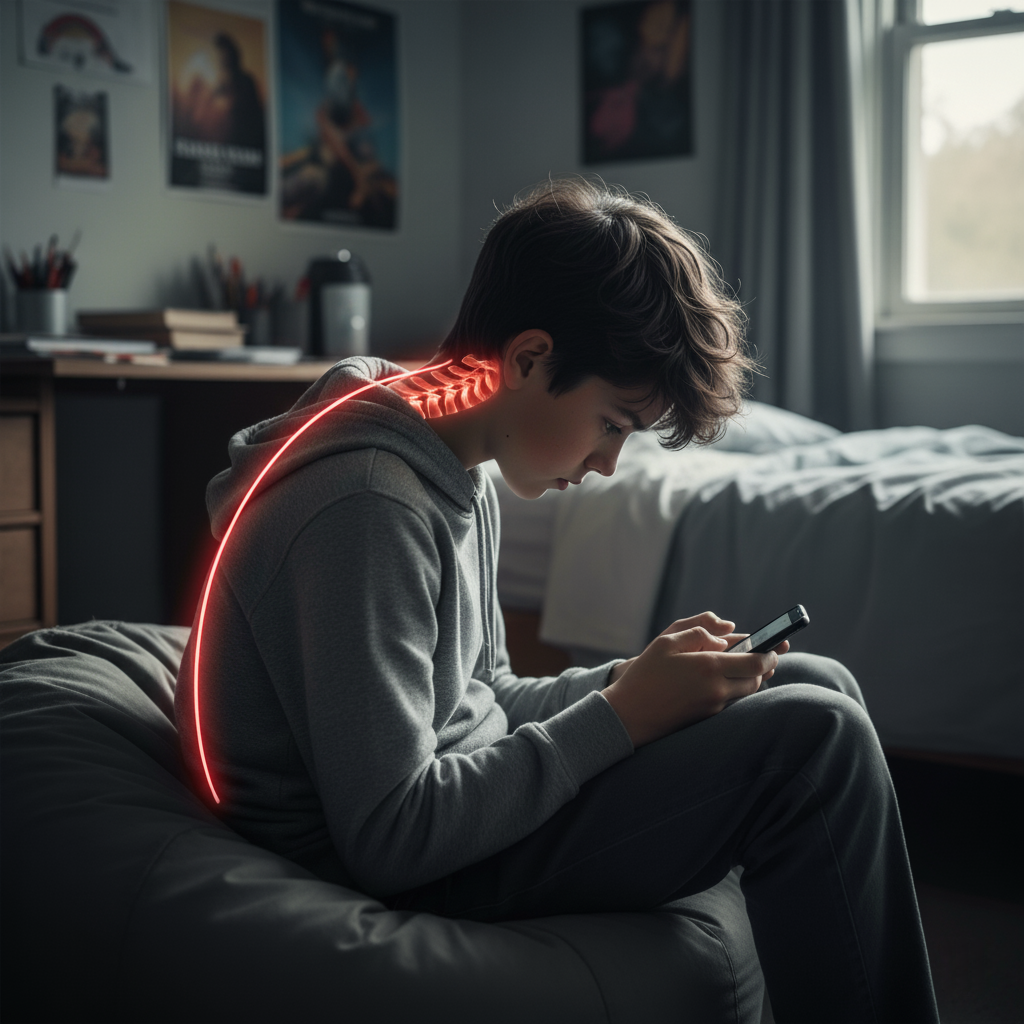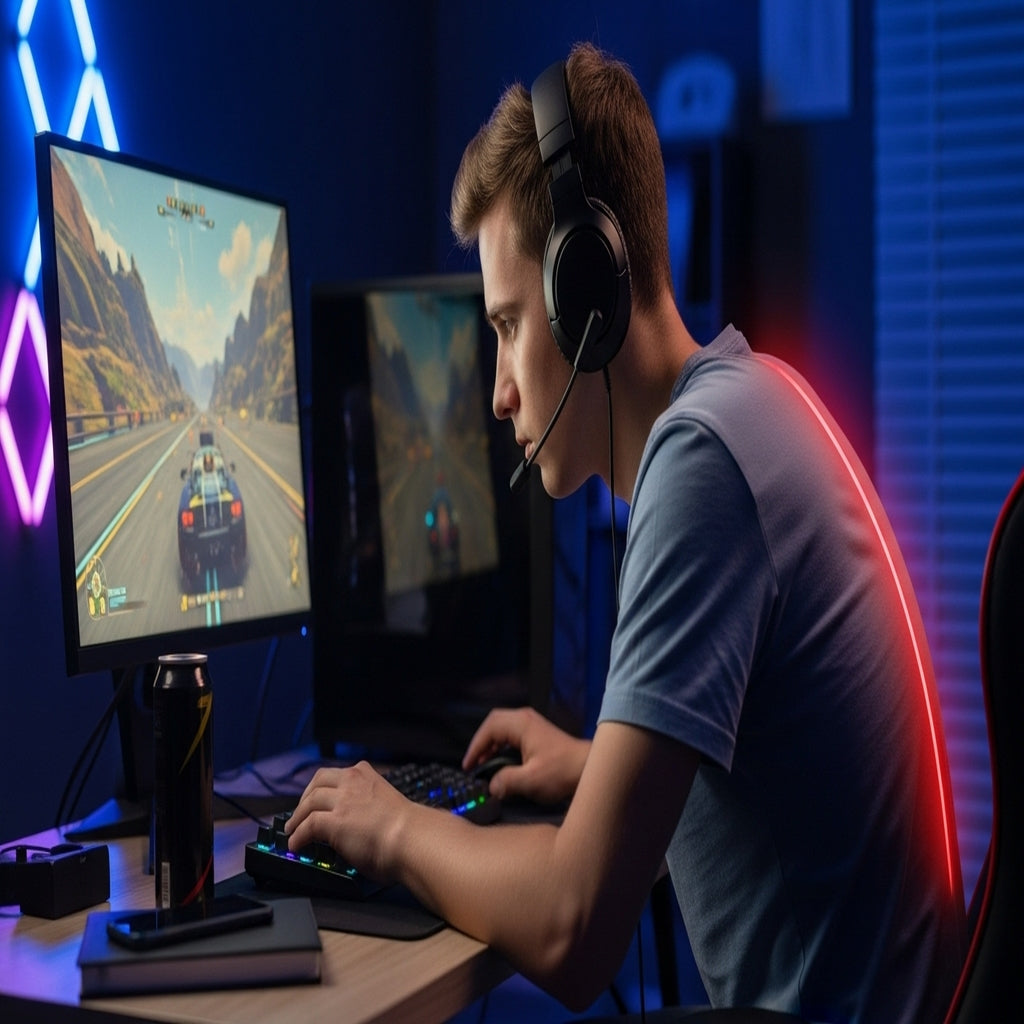Today’s children are growing up not on playgrounds but in front of screens. Whether studying, reading, doing homework on the computer, or watching videos on a phone — all these activities create the perfect conditions for posture problems to develop at an early age.
Yet, spinal development in children begins at birth and continues until around the age of 20–21.
However, the most critical and formative period is between 0–16 years old. The sitting, walking, and postural habits developed during this time determine the future health of the spine.

What Does Science Say?
Scientific studies clearly show a direct relationship between prolonged screen use and postural disorders.
- A 2023 study found that the frequency and dependency on smartphone use increase the forward tilt of the neck and back, leading to what is known among adolescents as forward head posture.

- Another 2021 study published on PubMed revealed that screen time and sitting posture negatively affect the head–neck alignment of elementary school children, proving how crucial screen height and posture are.
- A pilot study in IJPTRS reported that among children aged 10–15, increasing screen time was linked to a significant decrease in posture scores — meaning the longer a child looks at a screen, the less able they are to maintain spinal alignment.
- A thesis from Loma Linda University found that frequent smartphone use can negatively affect not only posture but even respiratory capacity.
What Does This Mean?
Prolonged screen use doesn’t just cause neck or back pain;
it also affects the long-term structural development of the musculoskeletal system during growth.
- Forward Head Posture: The head moves forward, and neck muscles bear constant strain.
- Rounded Back (Kyphotic Posture): Shoulders collapse, and the upper back curves.
- Shoulder Asymmetry: Caused by leaning to one side while using a tablet or phone.
- Reduced Breathing Capacity: The chest collapses forward, reducing lung volume.
These effects are not only physical — over time, they can influence confidence, focus, and learning capacity as well.
“Every hour spent in front of a screen creates microscopic changes in a child’s spine — and when it becomes a habit, those changes become permanent.”

What Should Parents and Schools Do?
- Limit screen time. Non-educational use should not exceed 1–1.5 hours per day.
- Apply the 30/5 rule: After every 30 minutes of sitting, take a 5-minute movement break.
- Keep the screen at eye level. The head should not tilt forward.
- Ensure ergonomic setup: Chair height, desk level, and screen distance should suit the child.
- Teach simple exercises: “Superman,” “plank,” and “wall alignment” exercises help correct posture.
- Integrate posture awareness programs in schools — children should understand why standing tall matters.

“Posture awareness gained early in life becomes a lifelong investment in health.”
Technology Can Be Part of the Solution, Not the Problem
Yes, technology contributes to posture issues in children.
But at the same time, innovations like AI-Modelled Posture Devices are helping solve this problem.
Kodgem Straight is one of the pioneers of this transformation:
- Its AI posture tracker detects spinal angles and forward tilting.
- With gentle vibration feedback, it guides children to correct posture naturally.
- Parents can monitor daily posture reports through the app.
Unlike posture braces, these smart devices don’t make muscles lazy — instead, they strengthen muscle memory and teach correct posture reflexes.
“The mission of AI for Health is to advance artificial intelligence in medicine and healthy living to enhance human health and well-being.”
Small Awareness, Big Gains
- Posture problems in children, if unnoticed, can lead to permanent issues during growth.
- To reduce the risk of postural disorders, screen time and seating arrangements must be adjusted.
- AI-Modelled Posture Devices are an effective tool for developing posture awareness in children.
- The Kodgem Straight experience helps children form proper postural habits through gentle vibrations.
- Posture awareness positively influences children’s confidence, attention span, and focus.
References
- Oliveira Fontenele TM, et al. (2023). Smartphone addiction and postural alterations in the cervical region. PMC
- Effects of smartphone screen viewing duration and body position on head and neck posture in elementary school children. PubMed
- Relationship between screen time and posture in children: cross-sectional pilot study. IJPTRS
- The Effects of Frequent Smartphone Use on Children’s Upper Posture and Pulmonary Function. Loma Linda University
- MIT Technology Review (2023). Wearable Tech & Health
- https://aihealth.stanford.edu/
💬 Time to Reflect:
👉 What’s your posture awareness story?
What have you tried to build posture awareness with your child? Share your experiences in the comments — let’s learn together. 🌱





Leave a comment
This site is protected by hCaptcha and the hCaptcha Privacy Policy and Terms of Service apply.